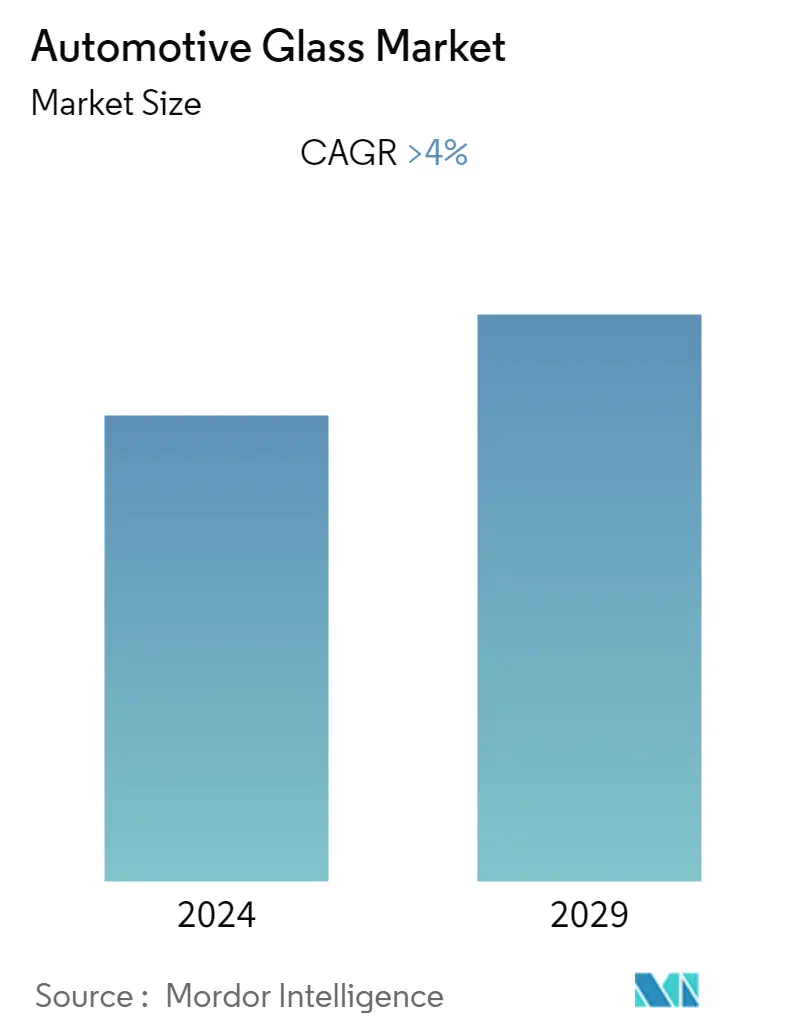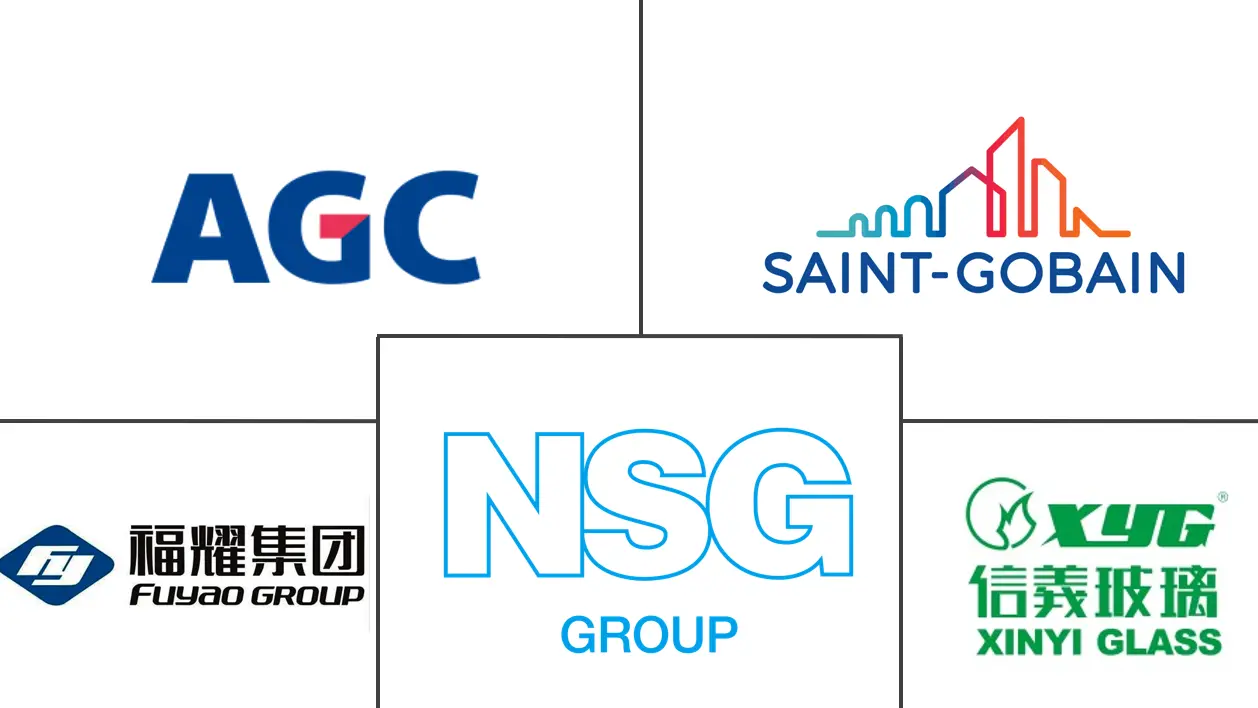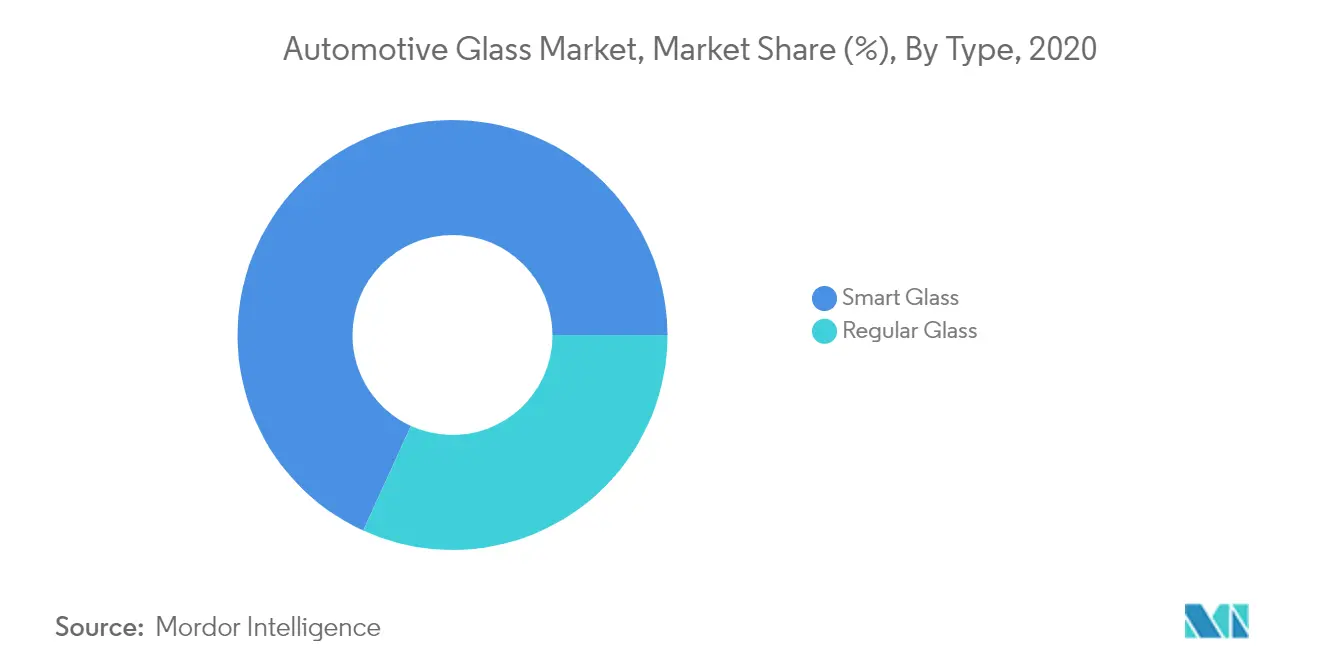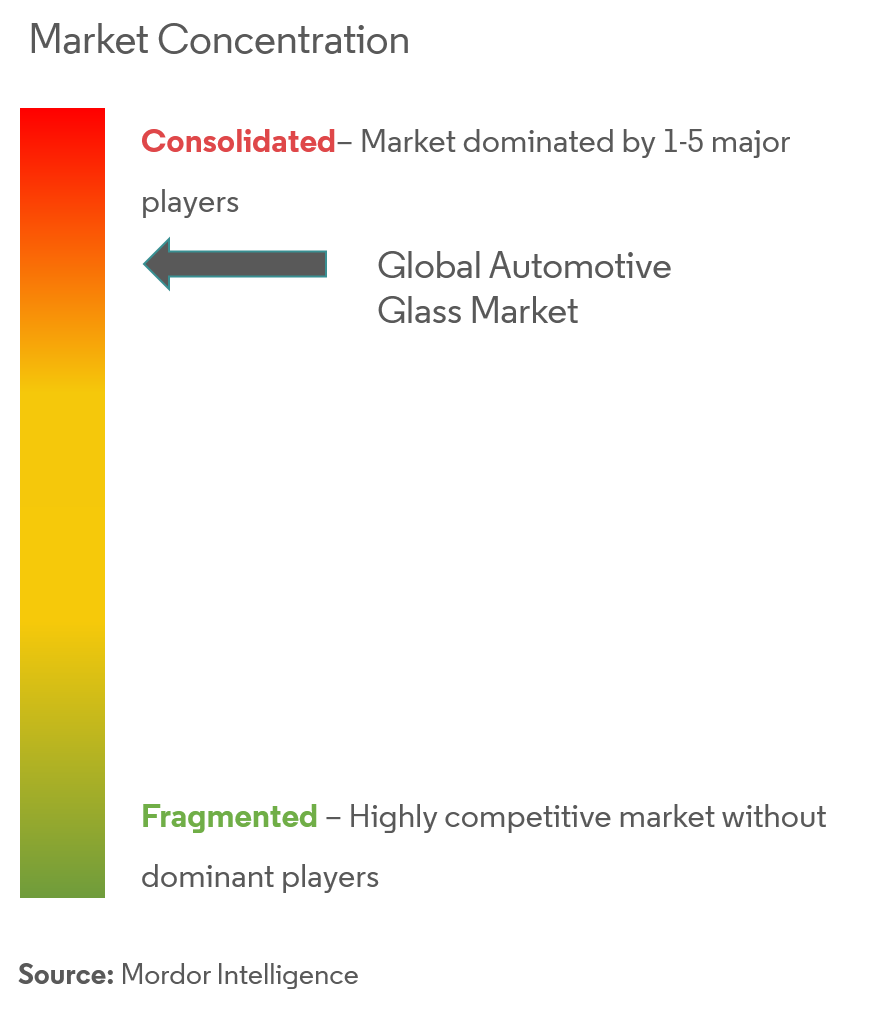Automotive Glass Market Size

| Study Period | 2019 - 2029 |
| Base Year For Estimation | 2023 |
| CAGR | 4.00 % |
| Fastest Growing Market | Asia Pacific |
| Largest Market | Asia Pacific |
| Market Concentration | High |
Major Players
*Disclaimer: Major Players sorted in no particular order |
Automotive Glass Market Analysis
The automotive glass market was valued at USD 19 billion in 2020, and it is expected to reach USD 23 billion by 2026, registering a CAGR of about 5% during the forecast period (2021 - 2026).
The coronavirus crisis has resulted in the temporary closure of automotive businesses around the world, hurting the short-term prospects of automotive glass producers. However, the demand arising from the nascent but fast-growing electric vehicle sector will enable fast recovery in the near future. Innovations in the automotive glass sector are increasingly focused on improving the material strength of the product. Chemically tempered glass has proven to be superior to conventional soda-lime glass options.
Higher strength in glass enables better safety, while the reduction in weight improves fuel efficiency. This attribute is rapidly gaining ground amid premium and sports car producers. Automotive glass products are also becoming increasingly larger, with some car companies even experimenting with full glass canopies. Such changes make efficiency performance-critical in terms of safety and comfort. Rising primary safety from accidents and rising consumer preferences in the application of glass in passenger's cars have created huge demand in the market for automotive glass. This is expected to fuel the integration of electronic sensors, cameras, and rearview mirrors into vehicle glass.
For instance, Saint-Gobain SA announced the acquisition of a 50% stake in China-based JJG Group for the flat glass production line, with an annual capacity of around 160,000 metric ton. The move will strengthen the flat glass supplies for Sekurit automotive glass production centers. It has also announced the development of a new flat glass production line in Saltillo, Mexico, for international supplies of automotive glass.
The market in Asia-Pacific is expected to dominate in the global market and is expected to continue its dominance over the forecast period, owing to rising consumer preference towards vehicle safety, comfort, and style. The market in Europe is expected to register the second-highest growth in terms of revenue over the forecast period, owing to the increasing vehicle manufacturing industry across various countries in this region. The market in North America is expected to register steady growth, owing to the declining production of passenger cars across various countries in the recent past.
Automotive Glass Market Trends
This section covers the major market trends shaping the Automotive Glass Market according to our research experts:
Increasing Application of Smart Glass in Automobiles
Automotive glass is a critical aspect of vehicles, with frequent innovations fueling growth. Among the improvements, the automotive smart glass market has been gaining major traction, especially in premium vehicle applications. These materials generate higher levels of comfort for passengers, with superior functionality in security, privacy, and temperature control, which will bolster market penetration in the years to come.
Smart glass options are rapidly finding growth in the production of sun and moon roofs, in line with changes with consumer bias and car manufacturing companies, especially in Europe. For instance, in January 2021, GM announced its new electric car, Cadillac Celestiq, which will come with a smart glass roof. The development of advanced ADAS systems in new automobiles will also contribute to growth in the industry.
Increasing usage of sunroof glass, particularly in high-end vehicles, is anticipated to positively impact the automotive glass market's growth. Nowadays, consumers are showing preference toward a sunroof in the car, which has led to an increase in the utilization of glass. Installation of the sunroof is now limited to the luxury car segment and has also been introduced to the other segments by car manufacturers, like Honda and Toyota. In addition, advancements in vehicle design have led to an increase in the size of the windshield and side windows, thereby leading to the overall development of the industry.
Smart glass has been forecast as the future of the automotive industry. Most of the research has been directed toward improving and making smart glass applicable to mainstream vehicles. It can be used to provide a head-up display in automobiles, just like in the glass cockpit of a helicopter. This makes access to all the controls much more comfortable and also enhances the ambiance of the vehicle. Manufacturers, like Mercedes and Volvo, are putting in a lot of effort to make this into a reality in automobiles.

Asia-Pacific is Expected to be the Fastest Growing Region
Asia-Pacific is expected to grow at the highest CAGR during the forecast period. Emerging economics and the strong presence of manufacturers in Japan, China, and India will boost the market in this region. Rapid changes in regulations to make transportation more advancing on the technology front and the ever-increasing population of this region will create more opportunities in the automotive glass market.
China is the biggest producer of automobiles in the world. The abundance of economic resources to assemble and manufacture automotive parts in India and China, the presence of established glass manufacturing players, increasing R&D capacities, and the presence of several new production plants in China to cater to the growing needs for electric cars are adding to the global automotive glass market growth in the region. For instance, in November 2019, a joint venture deal was signed between Volkswagen and SAIC to open its first manufacturing plant in Anting, China, which is expected to begin its production in October 2020 with an annual capacity of 300 thousand.
The growth in Asia-Pacific is also to be driven by the Indian automotive market, where the production is expected to increase significantly considering the BS-VI norms in the country. In January 2019, Kia Motors commenced trial production at its new 536-acre plant in Andhra Pradesh, with an annual capacity of 3 lakh units. Furthermore, in February 2019, the Government of India approved the Faster Adoption and Manufacturing of Hybrid and Electric Vehicles (FAME)-II scheme with a fund allocation of USD 1.4 billion from 2019 to 2022.
Such initiatives are expected to drive automotive production in the coming years, which, in turn, would drive the demand for automotive glass in the country. Some of the other rising markets in the Asian region are Vietnam, Indonesia, and the Philippines.

Automotive Glass Industry Overview
The automotive glass market is a consolidated one. The top global players account for almost 75% of the total market share. The major companies in the automotive glass market include Asahi Glass Co., Fuyao, Nippon Sheet Glass, Saint-Gobain, and Xinyi. Mergers and acquisitions and partnerships with regional automobile manufacturers are some of the dynamics that are shaping the competitive landscape of this market. For instance:
- Guardian Glass invested in the modernization of float glass lines at its European production plants. The United Kingdom plant will be upgraded and modernized, as the existing furnace is coming to the end of its lifecycle.
Automotive glass manufacturers are focusing increasingly on product development and launch strategies in a fairly fragmented global market. In addition, manufacturers are also investing in capacity and geographic expansions to keep up with international demand in the auto production sector. For instance:
- Asahi Glass Co. Ltd announced the development of a new float glass plant in Taloja, India, aimed toward glass production for the automotive and construction sectors, with a capacity of 550 metric ton per day. The company has also introduced a new dark green UV cut glass aimed toward application in passenger cars in India as an alternative to the illegal use of conventional tinted glass in the country.
- Fuyao Glass Industry Group Co. Ltd announced an expansion worth USD 45 million for a new automotive glass plant in Montgomery, Ohio, which will include equipment purchases and research and development investment.
Automotive Glass Market Leaders
-
Asahi Glass
-
Fuyao Group
-
Nippon Sheet Glass
-
Saint Gobain
-
Xinyi Glass
*Disclaimer: Major Players sorted in no particular order

Automotive Glass Market News
- In July 2021, Jeep's Performance Parts division (JPP) has introduced Gorilla Glass windshields for its Wrangler SUV and Gladiator pick-up truck models. JPP's new windshield is made with Corning Gorilla Glass. Its durability is ensured by Mopar's combination of an ultra-thin Gorilla Glass inner ply with a 52 percent thicker outer ply. Both the Jeep Wrangler and Gladiator have an upright windshield, which reduces the panel's ability to deflect a strike from a rock.
- In June 2021, Webasto, supplied the sliding panorama sunroof for the new Mercedes-Benz S-Class. The large glass surface provides a pleasantly bright ambiance in the sedan's interior. Shading can be provided as required via two separately controllable roller blinds. Operation of the modular roof system and blinds takes place conveniently and individually via gesture and voice control.
- In March 2021, Audi announced that all-electric Q4 e-tron crossover will have a dynamic windshield display. The AR windshield offers a wider field of view and more accurate and dynamic animations compared to a standard windshield HUD.
- In February 2020, AGC Glass Europe collaborated with citrine informatics to develop new glass technology using artificial intelligence. The data provided by AGC to build AI models helps to target the identification of the best process conditions to reach high-performance glass materials.
- In January 2020, BMW in the CES 2020 introduced intelligent glass control in the iNextits electric SUV, which is a reflective type of glass that can be activated both manually and automatically. Through various sensors, glass can pick up any specific position of the sun, through which only certain areas of the window will be adjusted to keep excessive heat and light away.
Automotive Glass Market Report - Table of Contents
1. INTRODUCTION
- 1.1 Study Assumptions
- 1.2 Scope of the Study
2. RESEARCH METHODOLOGY
3. EXECUTIVE SUMMARY
4. MARKET DYNAMICS
- 4.1 Market Drivers
- 4.2 Market Restraints
-
4.3 Industry Attractiveness - Porter's Five Forces Analysis
- 4.3.1 Bargaining Power of Suppliers
- 4.3.2 Bargaining Power of Consumers
- 4.3.3 Threat of New Entrants
- 4.3.4 Threat of Substitute Products
- 4.3.5 Intensity of Competitive Rivalry
5. MARKET SEGMENTATION
-
5.1 Type
- 5.1.1 Regular Glass
- 5.1.2 Smart Glass
-
5.2 Application Type
- 5.2.1 Windshield
- 5.2.2 Rear View Mirrors
- 5.2.3 Sunroof
- 5.2.4 Other Application Types
-
5.3 Vehicle Type
- 5.3.1 Passenger Vehicles
- 5.3.2 Commercial Vehicles
-
5.4 Geography
- 5.4.1 North America
- 5.4.1.1 United States
- 5.4.1.2 Canada
- 5.4.1.3 Rest of North America
- 5.4.2 Europe
- 5.4.2.1 United Kingdom
- 5.4.2.2 Germany
- 5.4.2.3 France
- 5.4.2.4 Spain
- 5.4.2.5 Rest of Europe
- 5.4.3 Asia-Pacific
- 5.4.3.1 China
- 5.4.3.2 India
- 5.4.3.3 Japan
- 5.4.3.4 Rest of Asia-Pacific
- 5.4.4 Rest of the World
- 5.4.4.1 South America
- 5.4.4.2 Middle-East and Africa
6. COMPETITIVE LANDSCAPE
- 6.1 Vendor Market Share
-
6.2 Company Profiles*
- 6.2.1 Asahi Glass Co.
- 6.2.2 Nippon Sheet Glass
- 6.2.3 Fuyao Group
- 6.2.4 Xinyi Glass
- 6.2.5 Saint Gobain
- 6.2.6 Guardian Automotive
- 6.2.7 Webasto
- 6.2.8 Benson Auto Glass
- 6.2.9 Carlex Glass
- 6.2.10 Magna International
7. MARKET OPPORTUNITIES AND FUTURE TRENDS
** Subject To AvailablityAutomotive Glass Industry Segmentation
In order to safeguard the driver and to provide smooth driving, different types of glasses are being used in automobiles. The automotive glass market report covers the latest trends and COVID-19 impact followed by technological developments in the market.
The scope of the report covers the segmentation based on type, application type, vehicle type, and geography. By type, the market is segmented as regular glass and smart glass. By application type, the market is segmented as windshield, rear view mirrors, sunroof, and other application types. By vehicle type, the market is segmented into passenger vehicles and commercial vehicles. By geography, the market is segmented into North America, Europe, Asia-Pacific, and the Rest of the world. For each segment market sizing and forecast have been done on basis of value (USD billion).
| Type | Regular Glass | |
| Smart Glass | ||
| Application Type | Windshield | |
| Rear View Mirrors | ||
| Sunroof | ||
| Other Application Types | ||
| Vehicle Type | Passenger Vehicles | |
| Commercial Vehicles | ||
| Geography | North America | United States |
| Canada | ||
| Rest of North America | ||
| Geography | Europe | United Kingdom |
| Germany | ||
| France | ||
| Spain | ||
| Rest of Europe | ||
| Geography | Asia-Pacific | China |
| India | ||
| Japan | ||
| Rest of Asia-Pacific | ||
| Geography | Rest of the World | South America |
| Middle-East and Africa |
Automotive Glass Market Research FAQs
What is the current Automotive Glass Market size?
The Automotive Glass Market is projected to register a CAGR of greater than 4% during the forecast period (2024-2029)
Who are the key players in Automotive Glass Market?
Asahi Glass, Fuyao Group, Nippon Sheet Glass, Saint Gobain and Xinyi Glass are the major companies operating in the Automotive Glass Market.
Which is the fastest growing region in Automotive Glass Market?
Asia Pacific is estimated to grow at the highest CAGR over the forecast period (2024-2029).
Which region has the biggest share in Automotive Glass Market?
In 2024, the Asia Pacific accounts for the largest market share in Automotive Glass Market.
What years does this Automotive Glass Market cover?
The report covers the Automotive Glass Market historical market size for years: 2019, 2020, 2021, 2022 and 2023. The report also forecasts the Automotive Glass Market size for years: 2024, 2025, 2026, 2027, 2028 and 2029.
What are the key challenges for Automotive Glass manufacturers in emerging markets?
The key challenges for Automotive Glass manufacturers in emerging markets are a) Meeting stricter safety standards b) Competition from low-cost producers c) Limited access to advanced technologies
Automotive Glass Industry Report
The automotive glass market is witnessing significant growth, fueled by the rising demand for passenger and commercial vehicles globally, due to population growth and technological advancements. This market, especially the automotive windshield market, is booming due to its crucial role in vehicle safety and the advent of smart glass technology, enhancing passenger comfort and vehicle efficiency. The Asia Pacific region, led by China and India, is the largest and fastest-growing market, driven by the surge in electric vehicle adoption and government support. The automotive glass market size is expanding, offering opportunities in OE-fitted laminated side glazing and smart glass technologies, despite challenges like high initial setup costs and slow tech adoption. With innovation, regulatory backing, and growing demand for safety and comfort, the market is set for continued growth. According to Mordor Intelligence™ Industry Reports, the automotive glass market is experiencing significant growth in market share, size, and revenue, underscored by a positive forecast outlook. For a comprehensive analysis, including historical data and market forecasts, access a free report PDF download from Mordor Intelligence™.



